Eskimo Bow Recovery
by Wayne Horodowich
When the original kayakers capsized exiting their kayak was
not an option because of the cold water. They had a variety of techniques
for getting upright. One of the techniques was getting an assist from a partner
in another kayak without having to wet exit.
The Eskimo bow assist is still very useful today even though
we don't have the restrictions of not wet exiting due to cold water. If we dress for immersion
a wet exit should not be a big deal. However, if an assist is nearby we can
save a lot of time and energy by staying in our overturned kayaks.
If your partner is in the vicinity of your kayak, this recovery method has less overall exposure time than if
you were to wet exit and do any of the assisted recoveries or solo recoveries. The Eskimo bow
recovery has provided me a great back up when I was learning my braces and
practicing my rolls. I was more apt to practice knowing I didn't have to wet
exit if I missed a roll or a brace. It is also a great way to quickly cool
off on a hot day without long immersion time.
Learning how to hang in your kayak when it is overturned is
a skill worth developing. The Eskimo recovery helps develop "hang time."
In addition, the basic movements of this skill are the ones used in rolling.
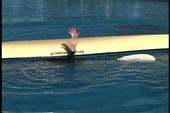 When you capsize and your partner is near enough to assist
you and they know this recovery method this is what to do. Lean forward as
close to the front deck as possible. Reach both hands into the air, one on
each side of your kayak. Your paddle can stay between your arm and your kayak. You will retrieve your paddle when you are upright. If help does not come, then you will still have your paddle next to you if you decide to wet exit.
When you capsize and your partner is near enough to assist
you and they know this recovery method this is what to do. Lean forward as
close to the front deck as possible. Reach both hands into the air, one on
each side of your kayak. Your paddle can stay between your arm and your kayak. You will retrieve your paddle when you are upright. If help does not come, then you will still have your paddle next to you if you decide to wet exit.
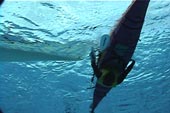 When you first go over bang on the bottom of your kayak to
get your partner's attention. Then keep your hands up in the air moving
them forward and backwards along the side of your kayak. Be sure to keep
your hands off of the kayak to prevent your hands from getting pinned and smashed
by the oncoming bow of your partner's kayak.
When you first go over bang on the bottom of your kayak to
get your partner's attention. Then keep your hands up in the air moving
them forward and backwards along the side of your kayak. Be sure to keep
your hands off of the kayak to prevent your hands from getting pinned and smashed
by the oncoming bow of your partner's kayak.
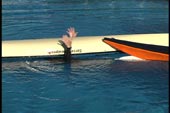 The person assisting can come in perpendicular to your
overturned kayak, on an angle or parallel. We will discuss the parallel
method another time. The parallel method uses the paddle shaft to right the capsized kayaker. (See USK Article "Eskimo
Paddle Recovery") I prefer to approach on an angle, because I can have the bow of my kayak slide along the hull of the capsized kayak until my bow is in the hands of the upside down paddler. Also, by coming in on an angle you can use the Eskimo Paddle
Recovery as a back-up if you over shoot your partner's hand.
The person assisting can come in perpendicular to your
overturned kayak, on an angle or parallel. We will discuss the parallel
method another time. The parallel method uses the paddle shaft to right the capsized kayaker. (See USK Article "Eskimo
Paddle Recovery") I prefer to approach on an angle, because I can have the bow of my kayak slide along the hull of the capsized kayak until my bow is in the hands of the upside down paddler. Also, by coming in on an angle you can use the Eskimo Paddle
Recovery as a back-up if you over shoot your partner's hand.
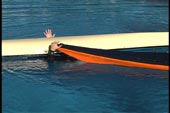 The goal of the assisting paddler is to put their bow into
your hands. By moving your hands you can feel their kayak if they come in
and just miss your hands. When upside down you can easily get confused as to the direction
from which your partner is approaching. That is why you keep both hands up
and moving.
The goal of the assisting paddler is to put their bow into
your hands. By moving your hands you can feel their kayak if they come in
and just miss your hands. When upside down you can easily get confused as to the direction
from which your partner is approaching. That is why you keep both hands up
and moving.
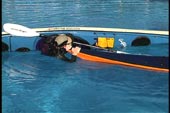 Once the bow is in your hand you can begin to pull yourself
up. Then you bring your opposite hand onto the bow. When both hands are on
the bow, pull you head up and rest it on the bow. This is a good time to take a breath since you have been holding
your breath for a while. If you did run out of air before your partner arrived,
you could come up for a quick breath and continue hanging. Pushing down with
both hands on one side can give you the lift you need to get that breath.
If you do try for that extra breath while waiting, be ready to protect you
face and head from the oncoming kayak.
Once the bow is in your hand you can begin to pull yourself
up. Then you bring your opposite hand onto the bow. When both hands are on
the bow, pull you head up and rest it on the bow. This is a good time to take a breath since you have been holding
your breath for a while. If you did run out of air before your partner arrived,
you could come up for a quick breath and continue hanging. Pushing down with
both hands on one side can give you the lift you need to get that breath.
If you do try for that extra breath while waiting, be ready to protect you
face and head from the oncoming kayak.
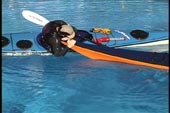 The next step is a basic movement for rolling your kayak.
Instead of pushing on the bow and lifting your head, it is easier to right
your kayak by using your leg and trunk muscles. The movement is commonly referred
to as a hip snap. If you look at the previous picture you can see the kayak
laying over the paddler. The hip snap gets the kayak upright then you bring
your head up. Believe it or not this movement takes less energy than trying
to lead with your head.
The next step is a basic movement for rolling your kayak.
Instead of pushing on the bow and lifting your head, it is easier to right
your kayak by using your leg and trunk muscles. The movement is commonly referred
to as a hip snap. If you look at the previous picture you can see the kayak
laying over the paddler. The hip snap gets the kayak upright then you bring
your head up. Believe it or not this movement takes less energy than trying
to lead with your head.
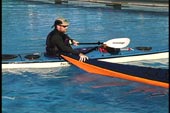 Once the kayak is upright, you can follow with your body making sure your
head comes up last. Once upright you can look for your paddle, which should
be nearby if you started with the paddle parallel to your kayak floating between
your arm and kayak.
Once the kayak is upright, you can follow with your body making sure your
head comes up last. Once upright you can look for your paddle, which should
be nearby if you started with the paddle parallel to your kayak floating between
your arm and kayak.
As you can see, the kayaker is now upright and they never had
to wet exit. As mentioned before, the overall immersion time is much less with
this recovery method as compared to one involving a wet exit.
Your submersion time is dependent upon how long it takes your
partner to get to you. Therefore your partner needs to practice their sprint
and and emergency stopping skills. Having a reliable stopping stroke that provides both stopping power and support is essential. (See USK article "Supportive
Reverse Sweep Stroke) You and your partner
should practice the assisting role so you can perfect your aim.
Again, I found this recovery method a great way to practice
my bracing and rolling. My partner would set up close by and come to get me
if I missed a brace or couldn't roll.
Of course this method is only as good as your ability to hold
your breath. The more relaxed you are the longer you will be able to stay
down. The colder the water the faster you will want to wet exit. We all know
how that ice cream headache feels. Trust me when I say "this gets easier with
practice."
When you are learning the skill do it in the reverse order of how I presented
the skill. Start with the hip snaps. Then go under but hold the bow with one
hand. Then go over next to the bow and then reach for it. Once comfortable
with the skill have your partner move farther away. Over time this recovery
method will be another one in you arsenal of recoveries.
Pictures seen above were taken from the USK Video "Capsize Recoveries and Rescue Procedures "
USK Home
Page
© Copyright USK
 When you capsize and your partner is near enough to assist
you and they know this recovery method this is what to do. Lean forward as
close to the front deck as possible. Reach both hands into the air, one on
each side of your kayak. Your paddle can stay between your arm and your kayak. You will retrieve your paddle when you are upright. If help does not come, then you will still have your paddle next to you if you decide to wet exit.
When you capsize and your partner is near enough to assist
you and they know this recovery method this is what to do. Lean forward as
close to the front deck as possible. Reach both hands into the air, one on
each side of your kayak. Your paddle can stay between your arm and your kayak. You will retrieve your paddle when you are upright. If help does not come, then you will still have your paddle next to you if you decide to wet exit. 


 Once the bow is in your hand you can begin to pull yourself
up. Then you bring your opposite hand onto the bow. When both hands are on
the bow, pull you head up and rest it on the bow. This is a good time to take a breath since you have been holding
your breath for a while. If you did run out of air before your partner arrived,
you could come up for a quick breath and continue hanging. Pushing down with
both hands on one side can give you the lift you need to get that breath.
If you do try for that extra breath while waiting, be ready to protect you
face and head from the oncoming kayak.
Once the bow is in your hand you can begin to pull yourself
up. Then you bring your opposite hand onto the bow. When both hands are on
the bow, pull you head up and rest it on the bow. This is a good time to take a breath since you have been holding
your breath for a while. If you did run out of air before your partner arrived,
you could come up for a quick breath and continue hanging. Pushing down with
both hands on one side can give you the lift you need to get that breath.
If you do try for that extra breath while waiting, be ready to protect you
face and head from the oncoming kayak. The next step is a basic movement for rolling your kayak.
Instead of pushing on the bow and lifting your head, it is easier to right
your kayak by using your leg and trunk muscles. The movement is commonly referred
to as a hip snap. If you look at the previous picture you can see the kayak
laying over the paddler. The hip snap gets the kayak upright then you bring
your head up. Believe it or not this movement takes less energy than trying
to lead with your head.
The next step is a basic movement for rolling your kayak.
Instead of pushing on the bow and lifting your head, it is easier to right
your kayak by using your leg and trunk muscles. The movement is commonly referred
to as a hip snap. If you look at the previous picture you can see the kayak
laying over the paddler. The hip snap gets the kayak upright then you bring
your head up. Believe it or not this movement takes less energy than trying
to lead with your head. Once the kayak is upright, you can follow with your body making sure your
head comes up last. Once upright you can look for your paddle, which should
be nearby if you started with the paddle parallel to your kayak floating between
your arm and kayak.
Once the kayak is upright, you can follow with your body making sure your
head comes up last. Once upright you can look for your paddle, which should
be nearby if you started with the paddle parallel to your kayak floating between
your arm and kayak.